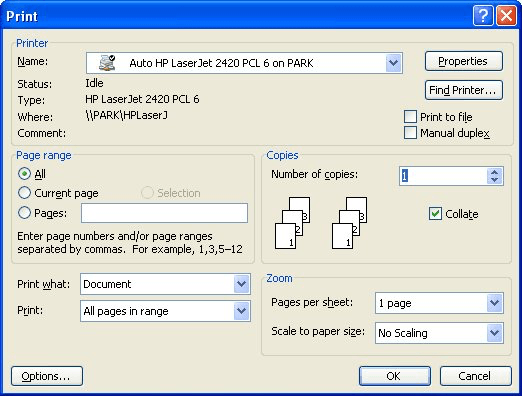Please Note: This article is written for users of the following Microsoft Word versions: 2000, 2002, and 2003. If you are using a later version (Word 2007 or later), this tip may not work for you. For a version of this tip written specifically for later versions of Word, click here: Scaling Your Output.
Written by Allen Wyatt (last updated December 19, 2020)
This tip applies to Word 2000, 2002, and 2003
You have been working on your document for hours. It is 35 pages long, and designed to be printed on legal-size paper. You decide to print the document, and discover you are out of legal paper. What do you do if you can't get any legal paper right away? You could reformat the document for letter-size paper, but that may not be the best solution.
Fortunately, Word includes a feature that allows you to independently specify a target paper size and an output paper size. This means you can format something for legal size, but instruct Word to scale the output so it will fit on letter size. This is very similar to a reduction setting on a copier. To take advantage of this feature, follow these steps:

Figure 1. The Print dialog box.
You should note that this scaling feature was introduced in Word 2000, so it is not available in Word 97.
WordTips is your source for cost-effective Microsoft Word training. (Microsoft Word is the most popular word processing software in the world.) This tip (1832) applies to Microsoft Word 2000, 2002, and 2003. You can find a version of this tip for the ribbon interface of Word (Word 2007 and later) here: Scaling Your Output.

Create Custom Apps with VBA! Discover how to extend the capabilities of Office 365 applications with VBA programming. Written in clear terms and understandable language, the book includes systematic tutorials and contains both intermediate and advanced content for experienced VB developers. Designed to be comprehensive, the book addresses not just one Office application, but the entire Office suite. Check out Mastering VBA for Microsoft Office 365 today!
When you create a document, you need to be concerned about the final size of the page you will be creating. Word supports ...
Discover MoreMany modern printers include multiple paper trays that can be used for different types or colors of paper. Word allows ...
Discover MoreIt always seems to happen—you print a document and then discover that you should have included one more line of ...
Discover MoreFREE SERVICE: Get tips like this every week in WordTips, a free productivity newsletter. Enter your address and click "Subscribe."
There are currently no comments for this tip. (Be the first to leave your comment—just use the simple form above!)
Got a version of Word that uses the menu interface (Word 97, Word 2000, Word 2002, or Word 2003)? This site is for you! If you use a later version of Word, visit our WordTips site focusing on the ribbon interface.
Visit the WordTips channel on YouTube
FREE SERVICE: Get tips like this every week in WordTips, a free productivity newsletter. Enter your address and click "Subscribe."
Copyright © 2025 Sharon Parq Associates, Inc.
Comments